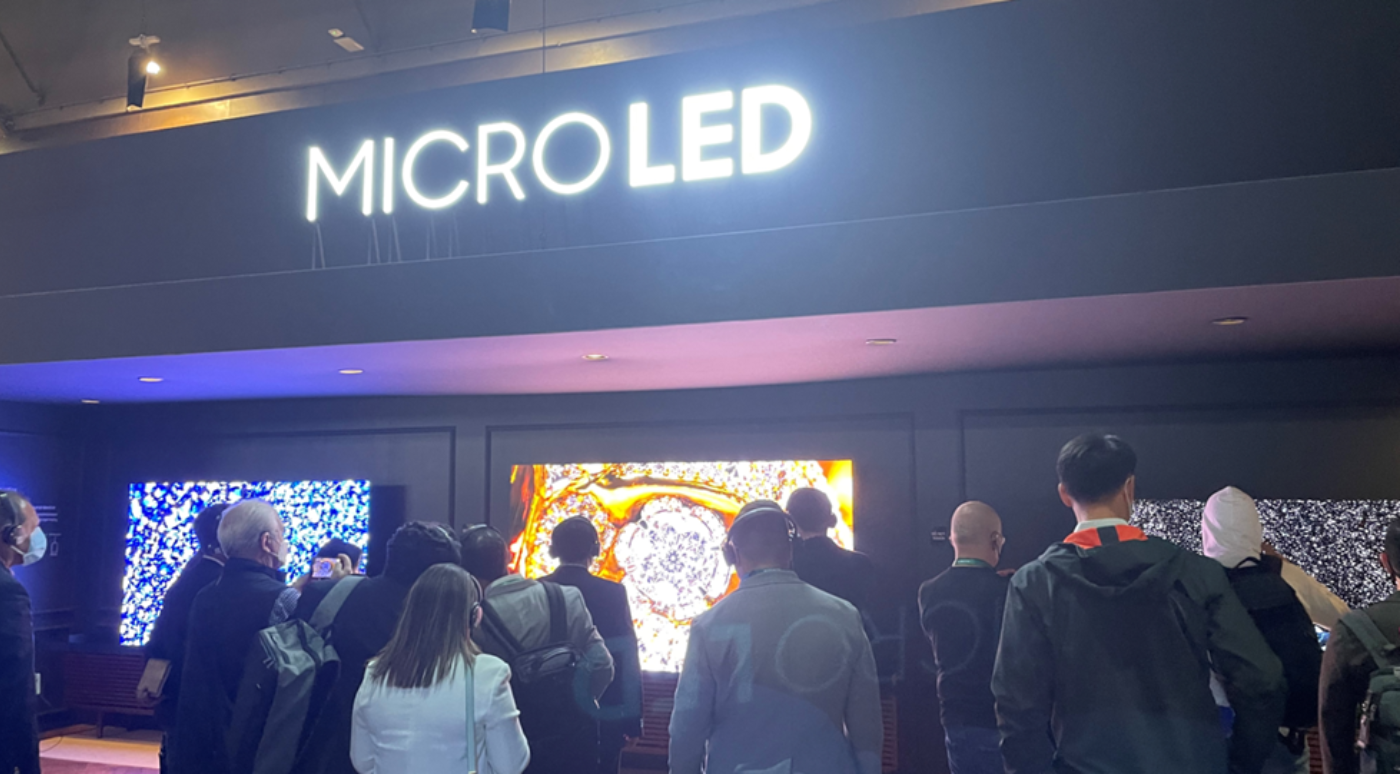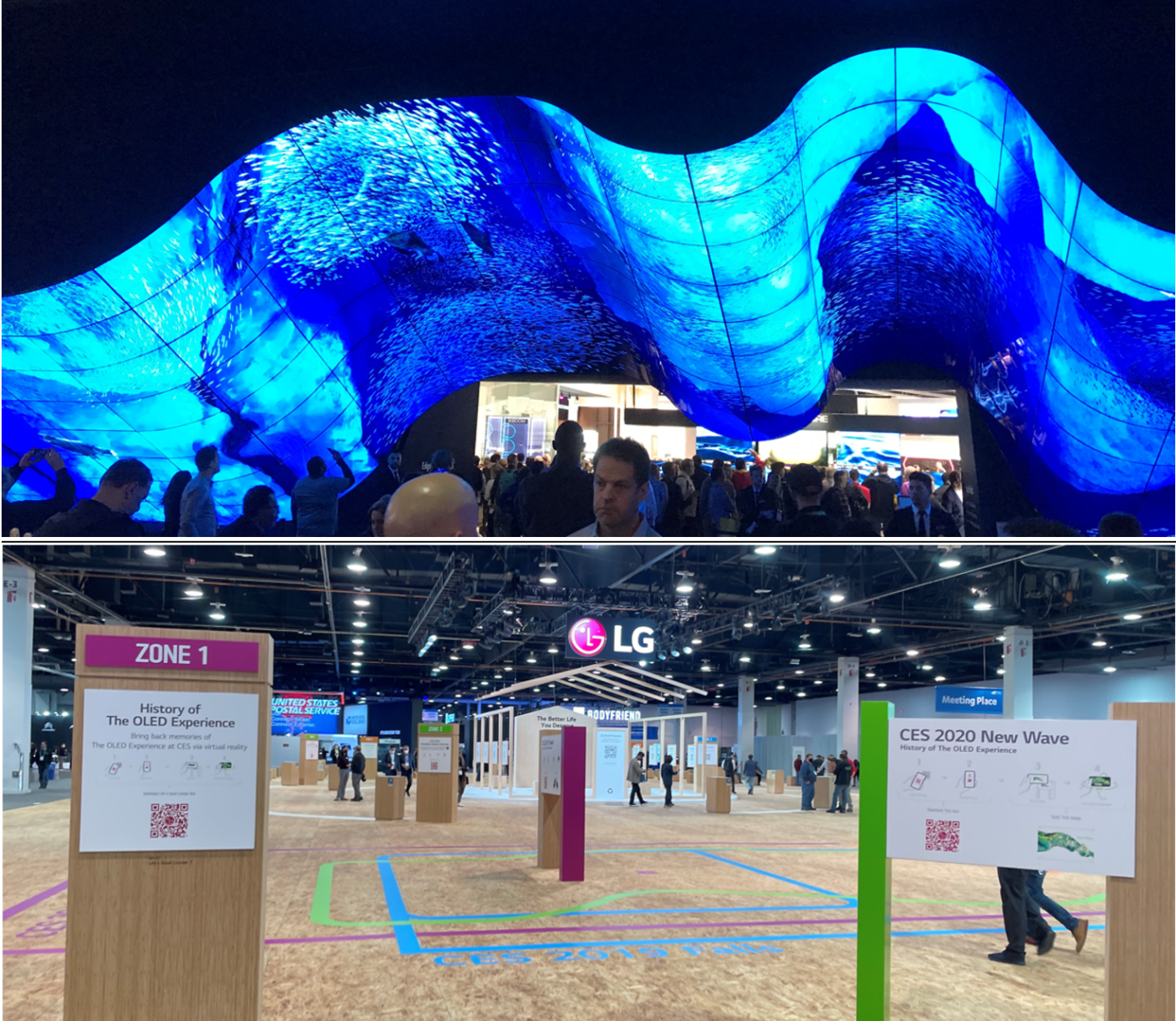CES 2022: In-Person Observations
CES 2022: In-Person Observations
Although it was greatly diminished in terms of the number of exhibitors and attendees, CES 2022 went forward as an in-person event. I am very glad I attended because I had quite a few productive meetings and saw new technologies with my own eyes.
Samsung Display QD-OLED
For me, the highlight of CES 2022 was Samsung’s QD-OLED display technology, to be introduced in TV and monitor products in 2022. The technology won CES Innovation Awards for both Samsung and Sony TVs. We describe Sony’s TV launch in a separate article, but Samsung did not announce a product launch during CES. Strangely, in my visit with Samsung’s TV group (see notes below), I was specifically asked not to mention this new technology as there were no product announcements and no communications about availability.
Fortunately, I was able to view QD-OLED at the private exhibition of Samsung Display (SDC, the panel maker supplying both Samsung TV and Sony, and supplying Dell with the 34” monitor panel). Although Samsung refers to this technology as QD-Display, I will continue to use our term QD-OLED. No pictures were allowed at the private exhibition.
We have described the basics of this technology many times in prior articles, but to summarize: QD-OLED includes an OLED panel emitting blue light combined with a quantum dot color converter (QDCC) which converts the blue light to red and green for each sub-pixel. My contact at Samsung Display mostly confirmed some elements of the QD-OLED architecture, but left a few items uncertain with a promise to follow up:
- The panel includes a color filter in front of the QDCC. This color filter does not filter much light coming from the panel but serves to enhance contrast by preventing ambient light from activating the quantum dots.
- The QDCC is inkjet-printed.
- The sub-pixel structure is unique. The RGB sub-pixels are not stripes, and they are not equal size. The details of the structure are confidential, but they will become readily apparent once the product hits the market.
- Samsung described the OLED as “self-emitting blue”. When asked about the rumor that Samsung included a green OLED emitting layer to boost brightness, my contact said he was unsure and would follow up.
In their exhibition, SDC compared its 65” QD-OLED TVs with WOLED TVs. To the best of my understanding, the comparison was with the C-series WOLED 2021 model; LGD rightly claims that its 2022 models are better. Although SDC makes many claims of the superiority of QD-OLED to WOLED, the biggest advantage that was apparent in the demonstration was color. QD-OLED clearly outperforms WOLED for color gamut; even my contact at LGD admitted this. The TV reaches 90% of the BT 2020 color triangle (based on the 1976 CIE color chart; it is 89% on the 1931 color chart that I am more familiar with), compared to 77% from WOLED. The difference was clearly viewable in the demonstration and will be demonstrable on the showroom floor.
Along with wide color gamut, the QD-OLED offers a superior color volume, also clearly demonstrated on scenes with bright red, green or yellow patches. Because the WOLED panels require a white sub-pixel to boost brightness, they do not show peak brightness of individual colors as well as they show white. In SDC’s demonstration, they claimed the following measurements in nits for peak R, G, B:
Peak Luminance (10% Window) for QD-OLED vs. WOLED per Samsung Display
While 2022 WOLED models would show improvements over these figures, QD-OLED will clearly be superior for this performance parameter.
SDC also claimed that its panels would outperform WOLED for burn-in, as they include Real Time Image Sticking Compensation that monitors the power characteristics of the three sub-pixels. Similarly, SDC said that QD-OLED has a wider viewing angle than WOLED because the light output of the quantum dots is Lambertian.
SDC described other features of the technology, but I don’t believe that any feature other than color, including burn-in and viewing angle, will drive consumer purchase decisions in any meaningful way. While QD-OLED may have an advantage for peak white brightness, the advantage over LG’s best offering in 2022 may not be very large.
Nevertheless, except for its much wider product portfolio I do not see any parameter where WOLED outperforms QD-OLED, and the advantage in color will enable SDC to credibly claim that it has the best flat panel for TV. Although I would love to see a neutral demonstration of QD-OLED vs. WOLED side-by-side, I saw enough in this demonstration and am convinced by some of the specification claims that QD-OLED indeed is the best flat panel for TV that money can buy.
The WOLED advantage in product portfolio should not be dismissed, however, as it points to a key potential advantage for LGD: manufacturability. We know that QD-OLED is an exceptionally complex product, with many new technologies that have never been manufactured at scale. We do not yet know whether SDC can make millions of these panels cost-effectively with good yields and high throughput. LGD had its own struggles in manufacturing WOLED, but those are nearly a decade in the past and LGD now boasts a broad product line ranging from 42” to 97” and including 8K panels. SDC will product QD-OLED with only two TV sizes with 4K resolution and one monitor size.
Samsung Visual Display Innovation Exhibit
Samsung’s TV group gave a private exhibition in their Innovation Room to highlight major features of their 2022 product line. Although my contact would not comment on the availability, configurations or pricing of QD-OLED TVs, Samsung had technology developments for demonstration.
Samsung has introduced for its 2022 product line several technologies to improve picture quality on its QLED 8K MiniLED TVs. The new TVs will have 14-bit contrast mapping for the MiniLED backlight, allowing a finer gradation of grey scale. The top-line peak brightness of the 2022 TVs is unchanged, but the 14-bit control of LEDs will improve low-light details. Samsung also will introduce Shape Adaptive Light Control for its MiniLEDs; this gives the OLED a spatial filter that can asymmetrically direct the LED light to improve contrast.
Samsung TVs will have a number of features targeted at improved performance for gaming, with a new SOC with high-speed decoding that improves input lag to less than 100ms. For games with HDR10+, the TVs work with a PC’s Nvidia processor to automatically go into game mode, and with 144Hz frame rate can reduce the delay time.
In its Lifestyle product The Frame targeted at art lovers, Samsung has added an AR treatment that allows for a glare-free screen, which greatly improves the simulation of a painting. This year Samsung adds a projector to its Lifestyle portfolio; the Freestyle projector comes with a smartphone-enabled app that will allow color calibration, so it the projector is pointed at a non-white surface, the projector can adjust the color with a simple 30 second calibration.
In its public exhibit space, Samsung highlighted its MicroLED technology. Although the attendance at CES was down 75% from pre-pandemic levels, one of the few places where 6-foot social distancing could not be managed was at the Samsung exhibit.
TCL
Alone among the top four TV brands, TCL showed a full TV product line at their CES 2022 booth. TCL maintains its flagship product for 2022, the X925 Pro MiniLED 8K TV with the company’s OD Zero technology in an 85” screen. With a big announcement of OD Zero last year, TCL had nothing similar to announce this year, but as a technology demonstration showed their next-generation of MiniLED designs, an Ultra Slim 8K MiniLED with more than 2000 zones and only 3.9mm thickness.
TCL continues to push 8K with MiniLED 6-series models in 65”/75”. TCL chose the 6-series to have a more affordable product line for 8K, and my contact at TCL indicated that they would look to expand the product line to larger sizes. TCL will introduce a 97” QLED TV in 2022, but this will be a 4K model and will not include MiniLED.
Elsewhere in the TCL booth they demonstrated NXTPaper tablets employing transflective LCD technology. That technology has never taken off before but its advantages for power consumption might lead to a revival in the education market.
TCL also showed a 6.67” foldable phone, which was intended to be introduced in 2021 but delayed. We believe that this product will start production in Q3 2022; it has a 6.67” foldable OLED screen in a clamshell design with a polyimide cover window.
Hisense
The only other TV brand showing a product line on the exhibition floor was Hisense, showing ULED MiniLED TV products in 65”/75”. Hisense included 8K as a technology demonstration, “8K: The Future of TV” implying that it was not a TV of today. Hisense also demonstrated its successful Laser TV projectors with configurations ranging from 75” to 120”. These RGB laser projectors claim 100% BT 2020 coverage (which, though not verified, is at least plausible with lasers). I found the 75” demo to be clearly inferior to flat panel displays of the same size with annoying laser speckle, but the 120” set-up with 430 nits brightness appeared to me to be an appropriate large-screen solution.
LG Electronics
Perhaps the most disappointing exhibit on the CES show floor was LG. In the years before the pandemic, LG consistently had the most impressive CES booth, usually by highlighting the company’s OLED TV technology in dramatic demonstrations involving hundreds of screens. Two years ago, LG showed OLED panels in waves as shown here.
In 2022, because of the pandemic LG did not bring a physical exhibit. Instead, it had a series of plywood kiosks, with a message on each including a QR code to see a virtual exhibit. While I understand the reasons that LG pulled back from a big on-site exhibition, the glaring reminder of the impact of the pandemic was painful to see. I sincerely hope that for CES 2023 LG can return to its former glory.
LG CES Exhibition in 2020 (top) and 2022 (bottom)
Skyworth
While not on the CES floor, Skyworth had a small private exhibit in the adjacent Westgate Hotel. Skyworth is seeking to build its business in the competitive US market and will bring an expanded product line to North America in 2022. Skyworth will continue to offer 55” and 65” OLED TV models with 60Hz and 120Hz configurations but will add MiniLED QLED sets in 65” and 75” screen sizes. In a move that might be even more important for success in the US, Skyworth has shifted production of its US product line to a factory in Mexico, allowing shorter lead times and direct shipments.
The Consumer Technology Association (CTA) said that attendance for CES 2022 was 40,000, which is down sharply from 180,000 in 2020 before the pandemic. While many important companies cancelled or severely restricted their in-person exhibitions, the conference provided in-person attendees the opportunity to see some new technologies and meet with industry professionals for the first time since the pandemic started. Although the event was not without some disappointments, the CTA should be commended for succeeding in holding the event.



